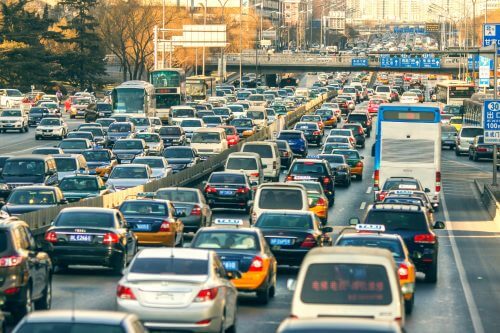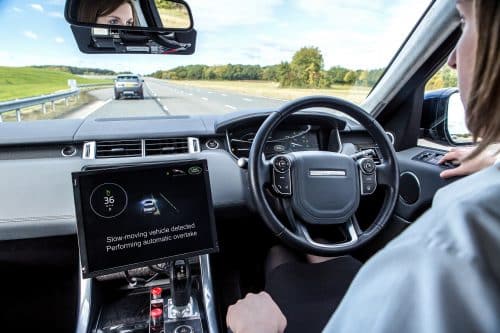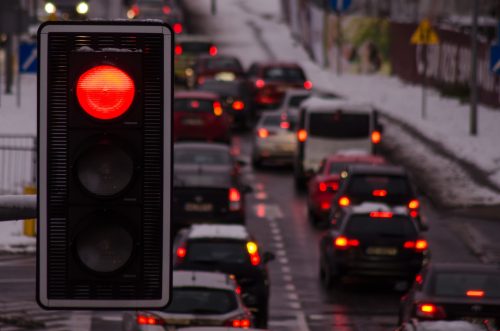Transportation networks of vehicles equipped with sensors and smart nodes will change from end to end the way we move in the city

The relationship between the cars in which we move and the cities in which we live is tangled and complex. Today, in view of the worsening problem of traffic congestion on the roads and a constant increase in air pollution levels, we tend to think that the two - the cars and the cities - cannot exist peacefully side by side. However, during the 20th century, vehicles left an indelible mark in the field of urban planning. And as the Swiss-born architect Le Corbusier declared in his groundbreaking book from 1925 The City of Tomorrow and Its Planning ("Tomorrow's City and Planning"): "The car...changed from end to end everything we thought about urban planning."
And now, almost a hundred years later, we find ourselves again at a similar turning point. First, the demand for urban transport is expected to double and more by 2050, and this means that we will have to double and even more the capacity of roads just to ensure thatTraffic congestion It will not exceed the (unbearable, often) levels we are experiencing today. Secondly, thanks to the rapid convergence of information and communication technologies, robotics and artificial intelligence, the transport systems by which we move from place to place - cars, buses and other means of transport - are undergoing far-reaching changes. And once again, these systems are about to reshape and fundamentally change the urban landscape.
Driverless cars (autonomous cars) leading the change. In recent decades, there has been a transformation in the automotive field, and the car is no longer a mechanical system of one type or anotherHenry Ford could identify as a vehicle, but, in fact, a computerized system on wheels. The average car today is equipped with a whole array of sensors that gather internal and external data to aid in its safe and efficient operation. Companies like Waymo (Originally, Google's driverless car project),Cruise (acquired by General Motors), Otto (acquired by Uber), zoox and- nuTonomy Experiments are being conducted with additional sensors capable of "seeing" the road and what is being done on it, in a similar way to how our eyes see what is happening on the road. When the information collected through the sensors is fed into an artificial intelligence system installed in the vehicles, a fully autonomous vehicle is obtained, capable of navigating busy transportation routes without the intervention of a human operator.
Autonomous vehicles will save a considerable part of the time we spend driving every day and at the same time, make the roads along which we drive safer. These vehicles are expected to be "game changers" when it comes to our cities - although it is still too early to predict in what ways they will change the urban fabric. On the one hand, we can assume that more and more people will switch to sharing the autonomous vehicles, so that they will drive passenger after passenger throughout the day. In this case, the number of vehicles moving in the city will be significantly reduced. On the other hand, we may witness more dystopian scenarios. Robyn Chase, the founder and former CEO of Sevitt car sharing Zipcar, story About "zombie cars - those in which no one sits - flooding and blocking our cities and roads". In her mind's eye, she foresees a bleak future of unemployment, loss of income from the transportation infrastructure and "a nightmare of air pollution, traffic congestion and social unrest" for the drivers whose livelihood is driving.
Technological nirvana or urban dystopia? To answer the question, we must thoroughly examine the ways in which autonomous vehicles may change the urban landscape and the ways in which we move through it.
Cooperative economy
In the current state of affairs, cars sit unused 96% of the time on average and thus, they are ideal candidates forCooperative economy. In the collaborative consumption of vehicles lies a huge potential for reducing traffic congestion. Already today, the influence of a handful of car sharing services - such as Zipcar and car2go - thanks to which the total number of vehicles moving on the roads of our cities has decreased considerably. Researchers estimate that every shared vehicle that goes on the road contributes to taking nine to 13 private cars off the road.
The profit inherent in car sharing services is expected to grow at a faster and faster rate as the autonomous vehicles, currently available only in experimental models, capture an increasing market share, and the distinction between private and public means of transportation will no longer be as sharp as before. "Your" private car can drive you to work in the morning and then, instead of staying in the parking lot, it can drive one of your family members - or any other person who lives in your neighborhood or any member of your social network.
In this way, one vehicle can be used throughout the day, from one hour to 24 hours a day. An article published by our colleagues at the Massachusetts Institute of Technology (MIT) reports that under these conditions, it will be possible to meet the transportation needs of a city like Singapore - where one of the world's first autonomous car fleets available for public use operates - using only 30% of the vehicles in the city . Besides car sharing, the autonomous car technology could open a new channel of ride sharing. Already enabling services like With, uberPOOL and- Lyft line Sharing trips of different people and thus these services contribute to saving the operating costs of the vehicles and the travel costs for each passenger. Autonomous car technology could further advance this ride-sharing trend, as all rides will be manageable online. The potential for sharing trips in cities is extremely significant, as shown by data analyzes conducted in our laboratory, Senseable City Lab (Smart City Lab), at MIT.
Large areas of urban land could be redeveloped and used for various social functions.
New York City, for example, is a classic candidate for this kind of resource sharing. as part of a project HubCab Conducted in our laboratory at MIT, we collected data from 170 million trips in 13,500 medallion taxis in the city (the yellow taxis) - more precisely, we collected the GPS coordinate data of all passenger pick-up and drop-off points and the travel times between each of these points, respectively. In the next step, we developed a mathematical model in order to calculate and define the potential impact of ride sharing on these trips. The project defined the concept of "sharing networks", which allow for optimal utilization of ride sharing opportunities. The quantitative results we received show how taxi ride sharing may reduce by 40 % of the total number of cars moving in the city, with only minimal delays for passengers.Additional research we conducted shows that other cities, such as San Francisco, Vienna and Singapore, could also benefit similarly from the idea of sharing transportation resources.

A great deal of benefit can be derived from car sharing and ride sharing together - and in this case, only 20% of the number of cars currently in use will be enough to allow the city's residents to move as needed. It is understood that these calculations are theoretical. Their implementation in the field depends on the willingness of the residents to implement the idea of sharing trips and adopt driverless car technology. However, any reduction in the number of vehicles in use will contribute to a reduction in the costs and energy involved in building and maintaining our transportation infrastructure. As the number of cars moving on the roads will be smaller, travel times are also expected to be shortened, traffic congestion will decrease andthe environmental damage will be reduced.
A city without parking lots, and without traffic lights
Autonomous vehicles will not require the development of additional urban infrastructure - specially designed roads for this purpose, for example - but they will bring about other weighty changes. Think, for example, of the parking lots. In the USA, the parking infrastructure covers an area of approximately 21,000 square kilometers - almost the area of New Jersey. As car sharing increases, the need for parking lots will decrease significantly. And what will be the consequences of this scenario?
Over time, large areas of valuable urban land that are currently used as parking lots will be vacated in favor of a redevelopment of the area that can be used for a wide range of social purposes. An annual event and its name Park (ing) Day, held for the first time in San Francisco in 2005, raises several ideas for the realization of the vision. Every year the organizers of the event go out with a call to artists, designers and ordinary citizens to propose proposals for converting paid parking areas into public spaces for one day. Among other things, in past events, the participants removed artificial grass mats and placed trees and benches along the edge of the sidewalks in the city streets.
And on a more extensive scale and on a regular basis, empty parking areas could be converted and used for the establishment of public facilities such as playgrounds, cafes, walking and jogging paths and cycling routes.
Other common sights that characterize the streets of our cities will also disappear. Think of the traffic lights, for example - a 150-year-old technology that was originally developed to prevent collisions between horse-drawn carriages. Driverless vehicles equipped with sensors will be able to communicate with each other in order to maintain a safe distance between them and cross intersections even without using traffic lights. Intersections where traffic is routed based on the allocation of time slots, according to the model of air traffic control systems, will be able to replace the traffic light system. When an autonomous vehicle approaches an intersection, a request for access to the intersection will be automatically sent from it to a traffic management system. The system will receive the request and assign him a unique time slot to cross the intersection.
Such smart intersections in which traffic is routed based on the allocation of time slots for crossing the intersection will significantly reduce traffic jams and other delays, as we demonstrated in the project Light Traffic. Analyzes we conducted show that systems that allocate time slots in real time will be able to allow double the number of vehicles to cross an intersection in a certain period of time, compared to the conventional traffic light system. Arrangements of this type are expected to have a far-reaching effect on the road system of each and every city. Travel and waiting times will be shortened immeasurably; fuel consumption will decrease; And traffic will flow freely, with fewer stops and accelerations, which will reduce air pollution. And as an added value, smart intersections where the traffic is routed based on the allocation of time slots for the passage of vehicles will also be able to route the movement of pedestrians and cyclists crossing the road.
It should be noted that the realization of this passionate vision depends not only on the autonomous vehicles and the smart traffic management systems. Its implementation will require maximum coordination between all the relevant players in the market. The companies currently operating in the car sharing market have their own independent platforms that do not communicate with each other. Thus, customers cannot easily compare the different options offered, while drivers cannot benefit from aggregated demand. This situation is similar to the one that prevailed in the field of air traffic in the days before the Internet. Today, travelers can compare a long list of flight alternatives using severalGlobal distribution systems applying standards set by the OpenTravel Alliance And thus enjoy greater transparency and competitive prices.
Two different approaches may lead to the creation of a similar transport mobility architecture in cities. One advocates bottom-up processes, where small players are the first to adopt standards. The seeds of this approach are already visible in the collaborations between San Francisco-based Lyft, the Chinese ride-sharing company Didi chuxing, the Indian Transport ServiceOla, And GrabTaxi active throughout Southeast Asia. The second approach is a top-down approach, according to which governments or global organizations, such as the World Wide Web Consortium, which deals with network integrity, are the leaders of the move. Since in most countries of the world transportation services are subject to extensive regulation, this approach is far from lacking a realistic basis. Either way, each of the two approaches can lead to the creation of a transparent and powerful platform for transportation and logistics services.
Possible obstacles
Autonomous vehicles and ride-sharing can bring about far-reaching changes for the better in urban transportation. But if the transition to a driverless city is not managed with due care, it may also have negative consequences.
The most troubling and worrying issue is the issue of safety. We are all aware of the devastating damage a virus can cause to our computer. And what will happen if a virus attacks the computer system in the car and causes it to crash? It is extremely difficult to combat malicious hacks into computer systems with the traditional tools available to governments and commercial entities, and such hacks can be especially dangerous when it comes to systems that include both digital and physical components, such as driverless cars.

Other problems can arise due to what can be called an "unfair competitive advantage" of autonomous vehicle technology. These may reduce the cost of travel per kilometer so sharply that passengers will abandon the public transportation system in favor of autonomous cars. This may later lead to an increase in the number of vehicles in the city - and with it, horribly congested and congested roads. Furthermore, continuous use of cars, throughout the hours of the day, as an alternative to leaving them unused 96% of the time, may increase air pollution.
The use of autonomous vehicles may have another undesired result: the expansion of theFlurry. And it will not be the first time that a technological innovation in the field of transport mobility leads to such a result. In his 1941 book, The Four Routes, Le Corbusier described a similar process that occurred in the first decades of the 20th century: "The railroad turned the cities into magnets, literally; They filled up and expanded without control, while the rural areas were gradually abandoned. It was a disaster. Fortunately, the automobile, through the road system, will restore the broken harmony and initiate the repopulation of the countryside." And what will happen in the future, what will happen if the people who will once again be able to travel every day from their home to their distant workplace and back, and in the process take a nap or set aside time for work, decide to move outside the city, a move that involves the utilization of land resources and the establishment of more and more suburbs that are not Exist in their own right?
Two other shortcomings of the autonomous car revolution are also worth noting in this context. First, the parking fees and the various taxes imposed on the use of vehicles, such as the various license fees, are a considerable source of income for various government and local authorities. Widespread use of autonomous vehicles could eliminate this vital source of funding. It is not difficult to imagine what will be the fate of the infrastructures across the USA, which are very fragile, if this scenario comes true. However, the redevelopment of parking lots that will no longer be needed and the establishment of new revenue-generating infrastructures in the vacated areas may be able to compensate the municipal authorities for the losses. We must also remember that millions of drivers worldwide who are currently employed in logistics services or in the urban transportation systems will find themselves jobless and without a source of income.
As Robin Chase wrote: "If we were content to take the driver out of the car and leave every other aspect of our system unchanged, it would be a disaster." We must therefore examine these new technologies with a critical eye - and steer them toward the social goals we desire. An informed policy can help prevent the negative consequences described here. And what was true in the 20th century is still valid today, and much will depend on a healthy process of Trial and error.
And yet, if we manage the transition in a calculated and thoughtful way, driverless cars can help us ensure a safer and more pleasant urban experience. And if we do so, we will be able to harness the autonomous car technology to fulfill the purpose of our cities, which has not changed since humans first established settlements, 10,000 years ago - to bring us together and bring us closer to each other, regardless of the vehicles in which we move.
About the writers
Carlo Ratti - Heads the Smart City Lab, Senseable City Lab, at the Massachusetts Institute of Technology (MIT). He is also the founder of the company for innovation, planning and architectural design named after him, Carlo Ratti Associati design studio.
Asaf Biederman - Inventor, co-director of Senseable City Lab, and founder of Superpedestrian, a company focused on developing robotic vehicles for one or two passengers.
for further reading
- Trash-to-Treasure: Turning Non-recycled Waste into Low-Carbon Fuel. Alex C. Breckel, John R. Fyffe and Michael E. Webber in EARTH, Vol. 57, no. 8, pages 42–47; August 2012
- The Upcycle: Beyond Sustainability—Designing for Abundance. William McDonough and Michael Braungart. North Point Press, 2013
- Carlo Ratti Associates design studio
- Superpedestrian
More of the topic in Hayadan:

2 תגובות
I wrote about this topic in 2014
http://www.tapuz.co.il/blogs/viewentry/7361574